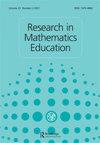On the design of paired comparison experiments with application
IF 1.1
Q2 EDUCATION & EDUCATIONAL RESEARCH
引用次数: 1
Abstract
In practice, paired comparison experiments involving pairs of either full or partial profiles are frequently used. When all attributes have a general common number of levels, the problem of finding optimal designs is considered in the presence of a second-order interactions model. The D-optimal designs for the second-order interactions model in this setting have both types of pairs in which either all attributes have different levels or approximately half of the attributes are different. The proposed optimal designs can be used as a benchmark to compare any design for estimating main effects and two and three attribute interactions. A practical situation that incorporates the corresponding second-order interactions is covered.配对对比实验的设计与应用
在实践中,经常使用成对的比较实验,包括全部或部分轮廓。当所有的属性都有一个通用的层次数时,在二阶交互模型的存在下,寻找最优设计的问题被考虑。在这种情况下,二阶相互作用模型的d-最优设计具有两种类型的对,其中要么所有属性都具有不同的水平,要么大约一半的属性是不同的。所提出的最优设计可以作为一个基准来比较任何设计估计主效应和两个和三个属性的相互作用。涵盖了包含相应的二阶相互作用的实际情况。
本文章由计算机程序翻译,如有差异,请以英文原文为准。
求助全文
约1分钟内获得全文
求助全文
来源期刊

Research in Mathematics Education
EDUCATION & EDUCATIONAL RESEARCH-
CiteScore
3.00
自引率
15.40%
发文量
40
 求助内容:
求助内容: 应助结果提醒方式:
应助结果提醒方式:


